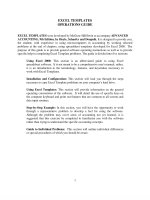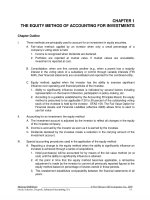Solution manual advanced accounting 2nd by hamlen CH04
Bạn đang xem bản rút gọn của tài liệu. Xem và tải ngay bản đầy đủ của tài liệu tại đây (1.28 MB, 44 trang )
Find more at www.downloadslide.com
CHAPTER 4
SOLUTIONS TO MULTIPLE CHOICE QUESTIONS, EXERCISES AND PROBLEMS
MULTIPLE CHOICE QUESTIONS
1.
b
Goodwill at the date of acquisition is $10,000,000 ( = $16,000,000 – 4,000,000 +
8,000,000 – 10,000,000). Goodwill at 1/1/14 is $10,000,000 – 2,000,000 = $8,000,000.
Land, buildings and equipment revaluation at 1/1/14 is a credit of $8,000,000 – [3 x
(8,000,000/20)] = $(6,800,000).
Intangibles revaluation at 1/1/14 = $10,000,000 – [3 x ($10,000,000/5)] = $4,000,000.
Eliminating entry R is as follows:
Goodwill
Identifiable intangibles
8,000,000
4,000,000
Land, buildings and
equipment
Investment in Salem
2.
b
Eliminating entry O is as follows:
Operating expenses
Land, buildings and equipment
2,100,000
400,000
Goodwill
Identifiable intangibles
3.
6,800,000
5,200,000
500,000
2,000,000
a
Calculation of Equity in Net Income:
Salem’s reported net income
Revaluation writeoffs:
Land, buildings and equipment depreciation
Identifiable intangibles amortization
Goodwill impairment loss
Equity in income of Salem
Solutions Manual, Chapter 4
$ 2,500,000
400,000
(2,000,000)
(500,000)
$ 400,000
©Cambridge Business Publishers, 2013
1
Find more at www.downloadslide.com
4.
c
Original cost
Change in Salem’s retained earnings to 1/1/14
3 years land, buildings and equipment depreciation
3 years identifiable intangibles amortization
Goodwill impairment loss to 1/1/14
Investment balance, 1/1/14
Equity in net income, 2014
Investment balance, 12/31/14
5.
c
Book value > undiscounted cash flows?
Fair value
Book value
Impairment loss
6.
Customer lists
No
--
Brand names
Yes
$3,400,000
5,200,000
$1,800,000
d
Step one: Division book value > fair value?
Step two:
Fair value of goodwill
Book value of goodwill
Impairment loss
7.
$ 16,000,000
14,000,000
1,200,000
(6,000,000)
(2,000,000)
23,200,000
400,000
$23,600,000
Division 1
Yes
Division 2
Yes
$1,000,000
1,600,000
$ 600,000
$8,000,000
6,400,000
-0-
Division 1
$14,000,000
16,000,000
2,000,000
$ 1,600,000
Division 2
$20,000,000
24,000,000
4,000,000
$ 4,000,000
c
Fair value of division
Book value of division
Potential goodwill impairment
Actual impairment loss
©Cambridge Business Publishers, 2013
2
Advanced Accounting, 2nd Edition
Find more at www.downloadslide.com
8.
d
Fair value
Book value
Impairment loss
9.
a
10.
a
Customer lists
$1,200,000
1,500,000
$ 300,000
Brand names
$3,400,000
5,200,000
$1,800,000
$500,000 – 100,000 = $400,000.
Solutions Manual, Chapter 4
©Cambridge Business Publishers, 2013
3
Find more at www.downloadslide.com
EXERCISES
E4.1
Equity Method Accounting
Calculation of Equity in Net Income:
Johnson’s reported net income
Revaluation writeoffs:
Plant assets $50,000,000/25
Goodwill impairment loss
Equity in net income of Johnson
Entries made by George during 2013:
Investment in Johnson
Capital stock
Investment in Johnson
$ 85,000,000
(2,000,000)
(20,000,000)
$ 63,000,000
500,000,000
500,000,000
63,000,000
Equity in net income of
Johnson
Cash
63,000,000
30,000,000
Investment in Johnson
E4.2
30,000,000
Equity Method Income and Working Paper Eliminations
(all amounts in millions)
a.
Investment balance, 1/1/14
Investment balance, 1/1/13 = $2,000 + $200
Change
2013 dividends
2013 equity income accrual
Writeoff of plant asset revaluation = ($160/10)
Saber’s 2013 net income
$2,286
2,200
86
60
146
16
$ 162
b.
Saber’s stockholders’ equity, 1/1/13
2013 net income
2013 dividends
Saber’s stockholders’ equity, 1/1/14
$2,000
162
(60)
$2,102
c.
Saber’s 2014 net income
Extra depreciation on revalued plant assets
Equity income accrual
$ 130
(16)
$ 114
©Cambridge Business Publishers, 2013
4
Advanced Accounting, 2nd Edition
Find more at www.downloadslide.com
d.
(C)
Equity income accrual
114
Dividends – Saber
Investment in Saber
(E)
Stockholders’ Equity –
Saber
40
74
2,102
Investment in Saber
2,102
(R)
Plant assets, net
Goodwill
144
40
Investment in Saber
184
(O)
Depreciation expense
16
Plant assets, net
e.
16
At the beginning of 2025, the plant assets are fully depreciated and the remaining balance
for goodwill is $40 - $30 = $10.
(R)
Goodwill
10
Investment in S
10
Entry (O) is not needed since no revaluations are written off in 2025.
Solutions Manual, Chapter 4
©Cambridge Business Publishers, 2013
5
Find more at www.downloadslide.com
E4.3
Consolidation at End of First Year
a.
The acquisition entry is as follows:
Investment in Saddlestone
Merger expenses
Capital stock
Contingent consideration
liability
Cash
10,300,000
250,000
10,000,000
300,000
250,000
Calculation of 2013 equity in net income:
Saddlestone’s reported net income
Revaluation writeoff:
Identifiable intangibles $2,000,000/5
Equity in net income of Saddlestone
Peak’s equity method entries for 2013:
Investment in Saddlestone
Equity in net income of
Saddlestone
Cash
$ 3,000,000
(400,000)
$ 2,600,000
2,600,000
2,600,000
1,000,000
Investment in Saddlestone
b.
Calculation of goodwill is as follows:
Acquisition cost
Book value of Saddlestone
Excess of acquisition cost over book value
Identifiable intangibles
Goodwill
Consolidation working paper eliminating entries for 2013:
(C)
Equity in net income of
Saddlestone
Dividends – Saddlestone
Investment in Saddlestone
(E)
Stockholders’ equity—
Saddlestone, 1/1
$ 10,300,000
(7,200,000)
3,100,000
(2,000,000)
$ 1,100,000
2,600,000
1,000,000
1,600,000
7,200,000
Investment in Saddlestone
©Cambridge Business Publishers, 2013
6
1,000,000
7,200,000
Advanced Accounting, 2nd Edition
Find more at www.downloadslide.com
E4.3
continued
(R)
Identifiable intangibles
Goodwill
2,000,000
1,100,000
Investment in Saddlestone
3,100,000
(O)
Amortization expense
400,000
Identifiable intangibles
E4.4
Eliminating Entries after First and Second Years
a.
Calculation of equity in net income for 2014:
400,000
Safeco’s reported net income
Revaluation writeoffs:
Equipment $500,000/5
Inventory
Goodwill impairment loss
Equity in net income of Safeco
$ 1,600,000
(100,000)
(200,000)
(50,000)
$ 1,250,000
Peerless’s entries for 2014:
Investment in Safeco
8,000,000
Cash
8,000,000
Investment in Safeco
1,250,000
Equity in net income of
Safeco
1,250,000
Cash
600,000
Investment in Safeco
600,000
Calculation of goodwill is as follows:
Acquisition cost
Book value of Safeco
Excess of acquisition cost over book value
Fair value less book value:
Equipment
Inventory
Goodwill
Solutions Manual, Chapter 4
$
$
500,000
200,000
$
8,000,000
(7,000,000)
1,000,000
(700,000)
300,000
©Cambridge Business Publishers, 2013
7
Find more at www.downloadslide.com
E4.4
continued
Consolidation working paper eliminating entries for 2014:
(C)
Equity in net income of
Safeco
1,250,000
Dividends – Safeco
Investment in Safeco
600,000
650,000
(E)
Stockholders’ equity—Safeco,
1/1
7,000,000
Investment in Safeco
7,000,000
(R)
Equipment, net
Inventory
Goodwill
500,000
200,000
300,000
Investment in Safeco
1,000,000
(O)
Depreciation expense
Cost of goods sold
Goodwill impairment loss
100,000
200,000
50,000
Equipment, net
Inventory
Goodwill
b.
100,000
200,000
50,000
Calculation of equity in net income for 2015:
Safeco’s reported net income
Revaluation writeoff:
Equipment $500,000/5
Equity in net income of Safeco
$ 2,000,000
(100,000)
$ 1,900,000
Peerless’s equity method entries for 2015:
Investment in Safeco
1,900,000
Equity in net income of Safeco
Cash
800,000
Investment in Safeco
©Cambridge Business Publishers, 2013
8
1,900,000
800,000
Advanced Accounting, 2nd Edition
Find more at www.downloadslide.com
E4.4
continued
The Investment in Safeco balance at December 31, 2015 is $8,000,000 + 1,250,000 –
600,000 + 1,900,000 – 800,000 = $9,750,000.
Consolidation working paper eliminating entries for 2015:
(C)
Equity in net income of Safeco
1,900,000
Dividends – Safeco
Investment in Safeco
(E)
Stockholders’ equity—Safeco,
1/1
800,000
1,100,000
8,000,000
Investment in Safeco
8,000,000
Stockholders’ equity—Safeco at 1/1/2015 = $7,000,000 + 1,600,000 – 600,000 =
$8,000,000
(R)
Equipment, net
Goodwill
400,000
250,000
Investment in Safeco
(O)
Depreciation expense
100,000
Equipment, net
Solutions Manual, Chapter 4
650,000
100,000
©Cambridge Business Publishers, 2013
9
Find more at www.downloadslide.com
E4.5
Equity Method, Eliminating Entries, Several Years after Acquisition
a.
Calculation of total goodwill is as follows:
Acquisition cost
Book value of Oslo
Excess of acquisition cost over book value
Fair value less book value:
Land
Buildings
Identifiable intangibles
Long-term debt
Goodwill
b.
$
450,000
(400,000)
1,000,000
250,000
6,000,000
(2,500,000)
3,500,000
(1,300,000)
$ 2,200,000
Calculation of Equity in net income for 2014:
Oslo’s reported net income
Revaluation writeoffs:
Buildings $(400,000)/20
Long-term debt $250,000/10
Goodwill impairment loss
Equity in net income of Oslo
c.
$
$ 450,000
20,000
(25,000)
(60,000)
$ 385,000
Calculation of Investment in Oslo, 12/31/14
Investment in Oslo, 1/1/06
Oslo’s reported income, 2006-2013
Oslo’s reported dividends, 2006-2013
Revaluation writeoffs, 2006-2013:
Buildings $[(400,000)/20] x 8
Identifiable intangibles (full balance)
Long-term debt $[250,000/10] x 8
Goodwill impairment loss
Investment in Oslo, 1/1/14
Equity in net income, 2014
Oslo’s dividends, 2014
Investment in Oslo, 12/31/14
©Cambridge Business Publishers, 2013
10
$ 6,000,000
4,000,000
(1,200,000)
160,000
(1,000,000)
(200,000)
(300,000)
7,460,000
385,000
(100,000)
$ 7,745,000
Advanced Accounting, 2nd Edition
Find more at www.downloadslide.com
E4.5
continued
d.
Consolidation working paper eliminating entries for 2014:
(C)
Equity in net income of Oslo
385,000
Dividends – Oslo
Investment in Oslo
(E)
Stockholders’ equity—Oslo, 1/1
100,000
285,000
5,300,000
Investment in Oslo
5,300,000
Stockholders’ equity, January 1, 2014 = $2,500,000 + 4,000,000 – 1,200,000 = $5,300,000.
(R)
Land
Long-term debt
Goodwill
450,000
50,000
1,900,000
Investment in Oslo
2,160,000
Buildings, net
240,000
Revaluations at January 1, 2014 = original revaluations less writeoffs for 2006-2013.
(O)
Interest expense
Buildings, net
Goodwill impairment loss
25,000
20,000
60,000
Long-term debt
Depreciation expense
Goodwill
Solutions Manual, Chapter 4
25,000
20,000
60,000
©Cambridge Business Publishers, 2013
11
Find more at www.downloadslide.com
E4.6
Consolidation after Several Years
Calculation of total goodwill is as follows:
Acquisition cost
Book value of Baker
Excess of acquisition cost over book value
Fair value less book value:
Buildings
Goodwill
$
7,500,000
(5,000,000)
2,500,000
(1,000,000)
$ 1,500,000
Calculation of equity in net income for 2013:
Baker’s reported net income
Revaluation writeoffs:
Buildings $1,000,000/25
Goodwill impairment loss
Equity in net income of Baker
$
300,000
$
(40,000)
(100,000)
160,000
Calculation of investment balance at December 31, 2013:
Investment in Baker, 12/31/06
Baker reported income, 2007-2012
Baker reported dividends, 2007-2012
Revaluation writeoffs, 2007-2012:
Buildings ($1,000,000/25) x 6
Investment in Baker, 1/1/13
Equity in net income, 2013
Dividends, 2013
Investment in Baker, 12/31/13
$ 7,500,000
1,300,000
(400,000)
(240,000)
8,160,000
160,000
(100,000)
$ 8,220,000
Consolidation working paper eliminating entries for 2013:
(C)
Equity in net income of Baker
160,000
Dividends – Baker
Investment in Baker
(E)
Stockholders’ equity—Baker, 1/1
100,000
60,000
5,900,000
Investment in Baker
5,900,000
Stockholders’ equity, January 1, 2013 = $5,000,000 + 1,300,000 – 400,000 = $5,900,000.
©Cambridge Business Publishers, 2013
12
Advanced Accounting, 2nd Edition
Find more at www.downloadslide.com
E4.6
continued
(R)
Buildings, net
Goodwill
760,000
1,500,000
Investment in Baker
2,260,000
Revaluations at January 1, 2013 = original revaluations less writeoffs for 2007-2012.
(O)
Depreciation expense
Goodwill impairment loss
40,000
100,000
Buildings, net
Goodwill
40,000
100,000
E4.7
Goodwill Impairment Losses
a.
Goodwill is not a standalone asset, but represents the value of above-average future
performance potential that cannot be assigned to identifiable assets such as property or
specific intangible assets. Because performance potential is related to business
operations, to measure impairments in its value it must be connected with a specific
business unit. In the case of Time Warner, as discussed in the text of Chapter 4, goodwill
is assigned to ―Networks‖ as a business unit. The WB Network was one part of this
business unit, but did not comprise the entire unit.
b.
First, Time Warner has the option to perform a qualitative analysis to determine if it is
more likely than not that the business unit’s book value exceeds its fair value. If so, the
fair value of the business unit is calculated and compared with its book value. If book
value exceeds fair value, we determine the amount of the impairment, if any, by
comparing the fair value of the goodwill with its book value. An impairment loss is
reported if book value exceeds fair value.
Since The WB Network was shut down, its future performance will no longer benefit
Time Warner, and the impairment charge is appropriate. Had the qualitative assessment
option been available in 2006, Time Warner would likely have bypassed this option due
to strong indicators that The WB Network’s future cash flows were significantly
impaired.
c.
Time Warner has a 50% interest in The CW, so under U.S. GAAP it does not have a
controlling interest and reports its investment using the equity method. Time Warner’s
equity in the net income of The CW is reported as part of consolidated other income. The
investment balance is reported as part of consolidated assets. The CW’s individual
assets, liabilities, revenues and expenses are not reported on the consolidated financial
statements.
Solutions Manual, Chapter 4
©Cambridge Business Publishers, 2013
13
Find more at www.downloadslide.com
E4.8
Projecting Consolidation Entries
a.
(R)
Land
Equipment, net
80,000
18,000
Investment in Samson
98,000
Inventory has been sold, and the equipment revaluation as of the start of the third year is
$30,000 – (2 x 6,000) = $18,000.
(O)
Depreciation expense
6,000
Equipment, net
b.
(R)
Land
6,000
80,000
Investment in Samson
80,000
Inventory has been sold, and the equipment revaluation has been completely written off.
Therefore no eliminating entry (O) is appropriate.
c.
No eliminating entries are necessary to recognize or write off the revaluations, because
the assets requiring revaluation have been either sold or written off.
©Cambridge Business Publishers, 2013
14
Advanced Accounting, 2nd Edition
Find more at www.downloadslide.com
E4.9
Identifiable Intangibles and Goodwill, U.S. GAAP
Amortization expense for 2014:
Customer relationships
Favorable leaseholds
Total
$4,000,000/4
$8,000,000/5
$ 1,000,000
1,600,000
$2,600,000
Impairment testing – identifiable intangibles:
Customer relationships
Book value = $4,000,000 – 2 x ($4,000,000/4) = $2,000,000
Book value > Sum of undiscounted cash flows? $2,000,000 > $1,200,000: Yes
Impairment loss = $2,000,000 - $900,000 = $1,100,000
Favorable leaseholds
Book value = $8,000,000 – 1.5 x ($8,000,000/5) = $5,600,000
Book value > Sum of undiscounted cash flows? $5,600,000 < $6,000,000: No
Brand names
Book value = $18,000,000
Book value > Sum of discounted cash flows? $18,000,000 > $7,000,000: Yes
Impairment loss = $18,000,000 - $7,000,000 = $11,000,000
Impairment testing – Goodwill:
Reporting Unit
Unit FV < BV?
Fair Value of GW
GW impairment loss
Asia
$400,000,000 > $300,000,000:
No
$350,000,000> $200,000,000:
No
$500,000,000< $600,000,000:
Yes
$500,000,000 – 385,000,000
= 115,000,000
$250,000,000 – 115,000,000 =
$135,000,000
South America
Europe
Summary:
Amortization expense – identifiable intangibles
Impairment losses – identifiable intangibles
Goodwill impairment loss
Total
Solutions Manual, Chapter 4
$
2,600,000
12,100,000
135,000,000
$149,700,000
©Cambridge Business Publishers, 2013
15
Find more at www.downloadslide.com
E4.10 Identifiable Intangibles and Goodwill, IFRS
Amortization expense for 2014:
Customer relationships
Favorable leaseholds
Total
$4,000,000/4
$8,000,000/5
$ 1,000,000
1,600,000
$2,600,000
Impairment testing – identifiable intangibles:
Customer relationships
Book value = $4,000,000 – 2 x ($4,000,000/4) = $2,000,000
Book value > Sum of discounted cash flows? $2,000,000 > $900,000: Yes
Impairment loss = $2,000,000 - $900,000 = $1,100,000
Favorable leaseholds
Book value = $8,000,000 – 1.5 x ($8,000,000/5) = $5,600,000
Book value > Sum of discounted cash flows? $5,600,000 > $4,400,000: Yes
Impairment loss = $5,600,000 – $4,400,000 = $1,200,000
Brand names
Book value = $18,000,000
Book value > Sum of discounted cash flows? $18,000,000 > $7,000,000: Yes
Impairment loss = $18,000,000 - $7,000,000 = $11,000,000
Impairment testing – Goodwill:
Reporting Unit
Unit FV < BV?
GW impairment loss
E. Asia
$150,000,000 < $200,000,000: Yes
$200,000,000 – 150,000 =
$50,000,000; impairment limited to full
goodwill balance of $40,000,000.
Indonesia
Brazil
Mediterranean
$120,000,000 > $100,000,000: No
$140,000,000 >$130,000,000: No
$190,000,000 < $220,000,000: Yes
Scandinavia
$230,000,000 < $300,000,000: Yes
Summary:
Amortization expense – identifiable intangibles
Impairment losses – identifiable intangibles
Goodwill impairment loss
Total
©Cambridge Business Publishers, 2013
16
$220,000,000 – 190,000,000 =
$30,000,000
$300,000,000 – 230,000,000 =
$70,000,000
$
2,600,000
13,300,000
140,000,000
$155,900,000
Advanced Accounting, 2nd Edition
Find more at www.downloadslide.com
E4.11 Consolidated Income Statement
a.
(amounts in millions)
Sales $5,000 + 2,000
Cost of goods sold $3,000 + 800 + 160
Gross margin
Depreciation expense $500 + 140 – (200/10)
Interest expense $100 + 60 + (100/5)
Other expenses $600 + 700
Total operating expenses
Net income
b.
$7,000
3,960
3,040
620
180
1,300
2,100
$ 940
Parson reports its own income of $800 million plus its equity in the income of Soaper of
$140 million. Equity in the income of Soaper is Soaper’s reported income adjusted for
write-offs of Soaper’s net asset revaluations. Consolidated income is Parson’s and
Soaper’s reported revenues and expenses, with Soaper’s expenses adjusted for the
revaluation writeoffs. Parson’s separately reported income and consolidated income
therefore report the same items, packaged differently.
Solutions Manual, Chapter 4
©Cambridge Business Publishers, 2013
17
Find more at www.downloadslide.com
E4.12 Amortization and Impairment Testing of Identifiable Intangible Assets
a.
Technology
Arroyo
WebEx
$15,000/5 x 9/12 =
$312,000/4 x 1/12 =
Customer Relationships
Arroyo
WebEx
$14,000/7 x 9/12 =
$153,000/6 x 1/12 =
Total amortization expense
$
2,250
6,500
1,500
2,125
$ 12,375
b.
Technology
Arroyo
WebEx
Customer
Relationships
Arroyo
WebEx
7/31/07
Book value>
Book
Undiscounted
value
cash flows?
Impairment loss
$ 12,750 $12,750>$14,000? No
--305,500 $305,500>$300,000? Yes $305,500-250,000 = $ 55,500
-12,500 $12,500>$16,000? No
$150,875-100,000
=
150,875 $150,875>$140,000? Yes
Total impairment loss
-50,875
$106,375
c.
Arroyo
WebEx
7/31/07 book value
©Cambridge Business Publishers, 2013
18
Technology
$ 12,750
250,000
$ 262,750
Customer
Relationships
$ 12,500
100,000
$ 112,500
Advanced Accounting, 2nd Edition
Find more at www.downloadslide.com
E4.13 Consolidation Using Cost Method
Calculation of total goodwill is as follows:
Acquisition cost
Book value of Baker
Excess of acquisition cost over book value
Fair value less book value:
Buildings
Goodwill
$
7,500,000
(5,000,000)
2,500,000
(1,000,000)
$ 1,500,000
Calculation of adjustment to investment balance to convert it to complete equity method at
January 1, 2013:
Baker reported income, 2007-2012
Baker reported dividends, 2007-2012
Revaluation writeoffs, 2007-2012:
Buildings ($1,000,000/25) x 6
Adjustment to Investment in Baker, 1/1/13
$ 1,300,000
(400,000)
(240,000)
$ 660,000
Consolidation working paper eliminating entries for 2013:
(A)
Investment in Baker
660,000
Stockholders’ equity –Adam
(C)
Dividend income – Adam
660,000
100,000
Dividends – Baker
(E)
Stockholders’ equity—Baker, 1/1
100,000
5,900,000
Investment in Baker
5,900,000
Stockholders’ equity, January 1, 2013 = $5,000,000 + 1,300,000 – 400,000 = $5,900,000.
(R)
Buildings, net
Goodwill
760,000
1,500,000
Investment in Baker
Revaluations at January 1, 2013 = original revaluations less writeoffs for 2007-2012.
(O)
Depreciation expense
Goodwill impairment loss
40,000
100,000
Buildings, net
Goodwill
Solutions Manual, Chapter 4
2,260,000
40,000
100,000
©Cambridge Business Publishers, 2013
19
Find more at www.downloadslide.com
PROBLEMS
P4.1
Condensed Consolidated Financial Statements One Year after Acquisition
a.
Calculation of equity in net income for 2014:
Santo’s reported net income
Revaluation writeoffs:
Inventory (1)
Plant assets $8,000,000/8
Patents $1,500,000/4
Long-term debt $1,000,000/10
Goodwill impairment loss
Equity in net income of Santo
$ 5,000,000
(2,000,000)
(1,000,000)
(375,000)
100,000
(400,000)
$ 1,325,000
(1) Santo’s beginning inventory on its own books is $3,000,000 (= $5,200,000 +
4,000,000 – 6,200,000). Since Santo’s cost of goods sold is $4,000,000, its
beginning inventory is completely sold in 2014, and the revaluation is written off.
b.
Consolidation Working Paper, December 31, 2014
Trial Balances Taken From
Books
Dr (Cr)
Eliminations
Consolidated
Ponon
Santo
Cash and receivables
Inventory
Plant assets, net
Investment in Santo
$ 4,500,000
5,000,000
8,000,000
26,325,000
$ 3,100,000
5,200,000
12,000,000
--
Patents
Goodwill
Current liabilities
Long-term debt
Capital stock
Retained earnings, Jan. 1
Sales
Equity in income of Santos
Cost of goods sold
Depreciation and
amortization expense
Interest and other expenses
GW impairment loss
--(5,100,000)
(20,000,000)
(8,000,000)
(4,800,000)
(30,000,000)
(1,325,000)
18,000,000
2,000,000
--(2,000,000)
(3,300,000)
(6,000,000)
(4,000,000)
(13,200,000)
-4,000,000
3,200,000
5,400,000
-$
-0-
1,000,000
-$
-0-
©Cambridge Business Publishers, 2013
20
Dr
Balances
Cr
$
(R) 2,000,000
(R) 8,000,000
(R) 1,500,000
(R) 4,500,000
(O-4) 100,000
(E) 6,000,000
(E) 4,000,000
2,000,000 (O-1)
1,000,000 (O-2)
1,325,000 (C)
10,000,000 (E)
15,000,000 (R)
375,000 (O-3)
400,000 (O-5)
1,000,000
(R)
(C) 1,325,000
(O-1) 2,000,000
(O-2) 1,000,000
(O-3) 375,000
(O-5) 400,000
$
31,200,000
100,000 (O-4)
_______
$31,200,000
7,600,000
10,200,000
27,000,000
--
1,125,000
4,100,000
(7,100,000)
(24,200,000)
(8,000,000)
(4,800,000)
(43,200,000)
-24,000,000
6,575,000
6,300,000
400,000
$
-0-
Advanced Accounting, 2nd Edition
Find more at www.downloadslide.com
P4.1
continued
c.
Consolidated Statement of Income and Retained Earnings For the Year 2014
Sales
$ 43,200,000
Costs of goods sold
(24,000,000)
Gross margin
19,200,000
Operating expenses:
Depreciation and amortization expense
$ 6,575,000
Interest and other expenses
6,300,000
Goodwill impairment loss
400,000
(13,275,000)
Net income
5,925,000
Retained earnings, beginning balance
4,800,000
Retained earnings, ending balance
$ 10,725,000
Consolidated Balance Sheet, December 31, 2014
Assets
Cash and receivables
Inventory
Plant assets, net
Patents
Goodwill
Total assets
Liabilities and stockholders’ equity
Current liabilities
Long-term debt
Capital stock
Retained earnings
Total liabilities and stockholders’ equity
Solutions Manual, Chapter 4
$
7,600,000
10,200,000
27,000,000
1,125,000
4,100,000
$ 50,025,000
$
7,100,000
24,200,000
8,000,000
10,725,000
$ 50,025,000
©Cambridge Business Publishers, 2013
21
Find more at www.downloadslide.com
P4.2
Equity Method and Eliminating Entries Three Years after Acquisition
a.
Calculation of equity in net income for 2014:
Sunset Coast’s reported net income for 2014
Revaluation writeoffs:
Plant assets ($1,000,000)/10
Identifiable intangibles $3,600,000/20
Equity in net income of Sunset Coast
$ 200,000
100,000
(180,000)
$ 120,000
Note: Identifiable intangibles at the date of acquisition are $2,100,000 + 500,000 +
1,000,000 = $3,600,000.
b.
Calculation of investment balance at December 31, 2014:
Investment in Sunset Coast, December 31, 2011
Sunset Coast’s reported income, 2012-2014
Sunset Coast’s reported dividends, 2012-2014 (50% of
reported income)
Revaluation writeoffs, 2012-2014:
Plant assets [($1,000,000)/10] x 3
Identifiable intangibles ($3,600,000/20) x 3
Investment in Sunset Coast, December 31, 2014
$ 3,500,000
850,000
(425,000)
300,000
(540,000)
$ 3,685,000
Note to instructor: Under LIFO and increasing inventory, the acquisition date
revalued inventory is assumed to still be on hand.
c.
Consolidation working paper eliminating entries for 2014:
(C)
Equity in net income of Sunset
Coast
120,000
Dividends – Sunset
Coast (.5 x $200,000)
Investment in Sunset
Coast
©Cambridge Business Publishers, 2013
22
100,000
20,000
Advanced Accounting, 2nd Edition
Find more at www.downloadslide.com
P4.2
continued
(E)
Stockholders’ equity—Sunset
Coast, 1/1
1,725,000
Investment in Sunset
Coast
1,725,000
Sunset Coast’s stockholders’ equity, December 31, 2011 = $1,400,000 (acquisition cost
$3,500,000 less excess over book value $2,100,000).
Sunset Coast’s stockholders’ equity, January 1, 2014 = $1,400,000 + (1 - .5)(850,000 –
200,000) = $1,725,000.
(R)
Identifiable intangibles
3,240,000
Inventory
500,000
Plant assets, net
800,000
Investment in Sunset
Coast
1,940,000
Revaluations at January 1, 2014 = original revaluations less writeoffs for 2012 and 2013.
(O)
Plant assets, net
Amortization expense
100,000
180,000
Depreciation expense
Identifiable intangibles
d.
100,000
180,000
Puffin’s income from its own operations plus equity in net income of Sunset Coast =
consolidated net income: $600,000 + $120,000 = $720,000.
Solutions Manual, Chapter 4
©Cambridge Business Publishers, 2013
23
Find more at www.downloadslide.com
P4.3
Consolidation at End of First Year, Preacquisition Contingency
a.
Calculation of equity in net income for 2013:
Sanders’ reported net income for 2013
Revaluation writeoffs:
Inventory $80,000 x 60%
Equipment $200,000/10
Equity in net income of Sanders
Perkins’entries for 2013:
Investment in Sanders
Merger expenses
Restructuring expenses
$ 500,000
(48,000)
(20,000)
$ 432,000
4,000,000
50,000
100,000
Cash
Investment in Sanders
4,150,000
432,000
Equity in net income of
Sanders
Cash
432,000
150,000
Investment in Sanders
b.
150,000
Consolidation working paper eliminating entries for 2013:
(C)
Equity in net income of
Sanders
432,000
Dividends – Sanders
Investment in Sanders
(E)
Stockholders’ equity—
Sanders, 1/1
2,200,000
Investment in Sanders
©Cambridge Business Publishers, 2013
24
150,000
282,000
2,200,000
Advanced Accounting, 2nd Edition
Find more at www.downloadslide.com
P4.3
Consolidation at End of First Year, Preacquisition Contingency
(R)
Inventory
Equipment, net
In-process research and
development
Goodwill
80,000
200,000
300,000
1,305,000
Lawsuit liability
Investment in Sanders
85,000
1,800,000
Note: Because the change in the lawsuit liability occurs within the measurement period,
the increased liability value increases acquisition date goodwill.
(O)
Cost of goods sold
Depreciation expense
48,000
20,000
Inventory
Equipment, net
P4.4
48,000
20,000
Consolidated Balance Sheet Working Paper, Bargain Purchase (see related P3.4)
(all amounts in millions)
a.
Calculation of equity in net income for 2013:
Saxon’s reported net income for 2013 ($10,000 + 10 – 8,000 – 40 – 25 – 1,600)
Revaluation writeoffs:
Inventory
Marketable securities
Buildings and equipment $300/20
Long-term debt $110/5
Equity in net income of Saxon
$ 345
(100)
50
(15)
(22)
$ 258
Calculation of Investment balance, December 31, 2013:
Investment balance, December 31, 2012 (1)
Equity in net income for 2013
Dividends for 2013
Investment balance, December 31, 2013
(1)
$2,000
258
(100)
$2,158
Paxon acquired Saxon for $1,800, but there is a bargain gain that increases the
investment balance by $200, as follows:
Solutions Manual, Chapter 4
©Cambridge Business Publishers, 2013
25









